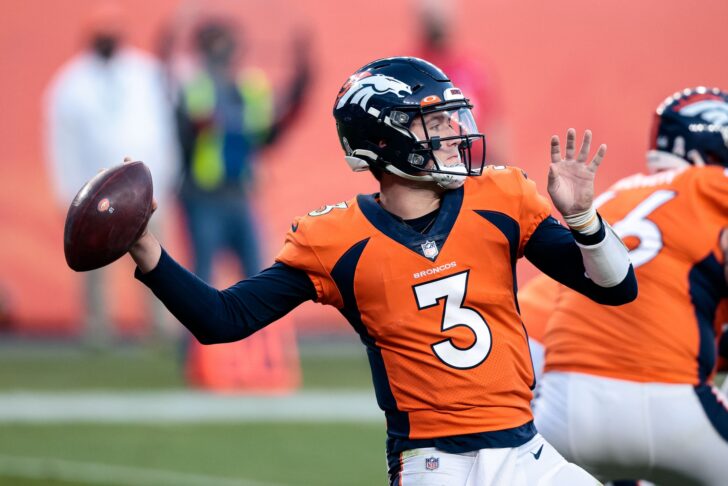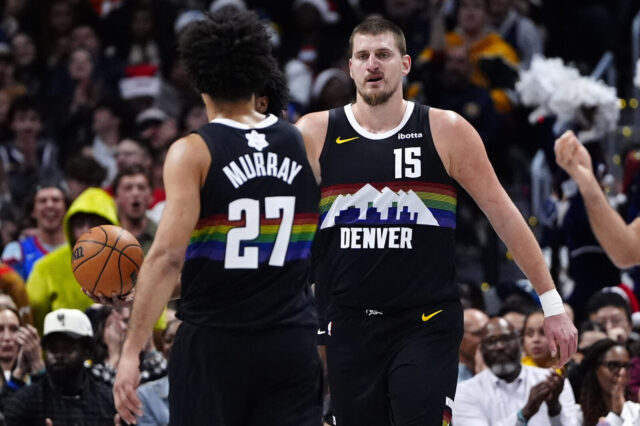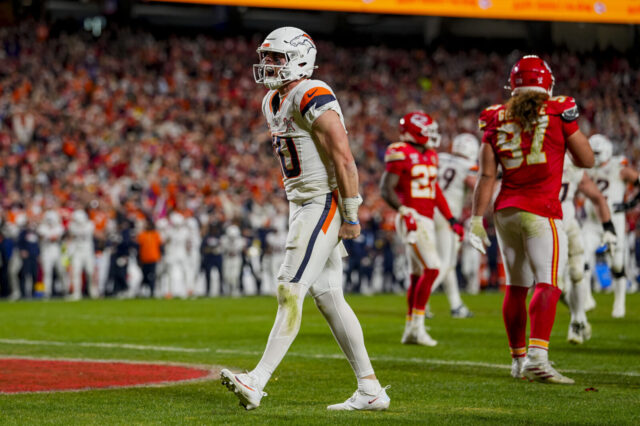The news of the offseason for the Denver Broncos has been, what will they do at quarterback and why will sit atop the depth chart?
Questions surrounding the team have covered almost every angle. First, how much the team likes the incumbent Drew Lock? Will the team will pursue a veteran in free agency? Is new General Manager George Paton go all in and make a trade for an established playmaker?
Finally, questions around the draft went on for months on end. Who would Denver take in the draft? Will they move up or move back? Is Justin Fields or even Mac Jones going to be a Bronco?
As we sit now, the quarterback depth chart is still unresolved. Conversations continue around the likelihood Paton strikes a match and makes a ground-shattering move.
It makes sense as to why the focus has been on the performance of Lock or anyone else brought in to challenge him. The 2021 Broncos are stacked with talented players up and down the roster. However, they will only go as far as the quarterback position takes them.
Pro Football Focus has the Broncos roster ranked as the 6th best roster with Lock at the helm. If the team has improved play behind center, they can be a scary matchup for any opponent.
Before anyone can worry about what might be or what will not be, they must consider what is. As the roster sits now, the quarterback room consists of Lock, Teddy Bridgewater, and Brett Rypien.
Lock and Rypien are young players returning for another year in offensive coordinator Pat Shurmur’s offense.
Bridgewater, the former Carolina Panthers’ starting quarterback, comes to Denver following an underrated pre-draft-day trade.
QB trade! #Broncos are acquiring QB Teddy Bridgewater from the #Panthers for a 6th-round pick, per NFL Network. Competition for Drew Lock, and GM George Paton gets a QB he’s familiar with.
— Ari Meirov (@MySportsUpdate) April 28, 2021
The Broncos are planning on having a very real competition at quarterback between Lock and Bridgewater, despite some skepticism from fans and media.
At the bottom of the depth chart
Brett Rypien compiled 395 yards passing while throwing 2 TDs and 4 INTs. Most importantly, Rypien came off of the bench to lead the Broncos to their first victory of 2020.
Rypien is a cerebral player with a limited physical skill set. With a smaller frame and below-average arm, Rypien will likely never become a starting-caliber quarterback in the NFL.
His value for this team has a lot to do with his ability to understand the offense and his connection with Drew Lock.
However, with the talent on this roster and the addition of Bridgewater, the need for Rypien reduces significantly.
The team may look to stash him on the practice squad again in 2021, as they did to start last season. With the improved depth in this roster, Rypien’s spot can be used by another position player who carries more impact game in and game out.
Rypien will need an impressive camp, and some luck, to hang around the active roster to start the regular season.
The Plan: Competition at the top of the depth chart
The plan for Denver was always to bring in a veteran to put pressure on Lock during training camp, and also serve as a solid veteran presence.
“Acquiring Teddy Bridgewater adds competition, experience and a strong veteran presence to our quarterback room."
GM George Paton on agreeing to trade for @teddyb_h2o: pic.twitter.com/lHgKRGVX2x
— Denver Broncos (@Broncos) April 28, 2021
Many are not moved much by the addition of Bridgewater. He fizzled as the season wore on, but has been a consistently safe option throughout his career.
Bridgewater returns to a Shurmur offense he studied under before the injury that cost him all of the 2017 season and derailed a promising career.
Bridgewater has a career completion percentage of 66%, and a 3TD:2INT ratio. His numbers over the last five years would have been more than welcomed by the fans compared to what they’ve gotten since Peyton Manning’s retirement.
In theory, Bridgewater’s presence provides the team with insurance for Lock as a steady player that can complement the defense by minimizing turnovers
But Bridgewater’s 2020 does not show a significant difference from Lock in ball security. To win the job, Bridgewater must be able to pick up critical 3rd downs and convert in the red zone. Both areas he underwhelmed in 2020.
Enter Drew Lock into the conversation
Drew Lock struggled in 2021 with injuries and inconsistencies. When he was “on” his performances were amazing, highlighted by a 4TD performance against Bridgewater and the Panthers late in the season.
Lock’s age (24 to 29) and a superior physical skill set compared to Bridgewater provide the “upside” argument as to why he should get the nod at the top of the depth chart.
Lock’s mobility and above-average arm strength are what make people believe the 3rd year player can be something special.
The top plays from @DrewLock23's sophomore season with the @Broncos! pic.twitter.com/hOgiLPPldu
— NFL (@NFL) March 22, 2021
As the team evenly splits reps in training camp, the two players will look to separate themselves by being a little bit more like the other.
For Lock to win the job, he must reduce turnovers while continuing to present the big play.
Bridgewater on the other hand, must be more aggressive and take more risks if they present themselves.
Analysis of the quarterback depth chart
Lock enters the offseason as the starter, and rightfully so.
Though you could look at Bridgewater as the safer option based on their 2020 statistics, the play down the Steve stretch for both would indicate something different. Bridgewater became more turnover prone while Lock became safer with the football.
Lock’s improvement over the last 6 games of the 2020 season came as he seemed to settle into the offense. Statistically, he was a much better player than early on.
Over the last six games, he averaged 240yds/game passing with a touchdown to interception ratio of 9:5 over his last 6 games.
Lock’s youth and upside present the opportunity for a much more diverse offense than Bridgewater.
Additionally, Lock comes into the competition with a leg up after spending last season in the offense and forming a connection with all of the returning players.
Bridgewater provides a much more reliable option should Lock falter, or more likely, suffer an injury as he has in his first two NFL seasons.
Rypien only makes the roster if the team feels they can sneak some really talented players on the practice squad.
QB depth chart
As we sit today, here is how the depth chart will shake out.
QB1 – Drew Lock
QB2 – Teddy Bridgewater
QB3 – Brett Rypien
The plan this offseason all along was to allow Lock to have some consistency while bringing in a vet to raise the floor of the room and apply pressure he did not have last year.
Bridgewater is that guy and should provide the quarterback room a veteran presence as Lock takes the helm.
Game changer
The only way the depth chart changes is a trade for Aaron Rodgers.
If that move presents itself, the team has to explore it. For instance, oddsmakers have the Broncos as a team that may challenge for a playoff spot with their current quarterback situation.
Making a move to get Aaron Rodgers the team’s outlook changes significantly as the team’s Super Bowl odds jump significantly jump.
As do their expectations.
Any expected deal with the Green Bay Packers would suggest either Lock or Bridgewater heading back in return. The remaining quarterback would serve as the backup to Rodgers.
The most likely scenario in a Rodgers deal is Bridgewater heads to the Packers to serve as a bridge to Jordan Love, and Lock stays to learn under the future Hall of Famer.
In the end, I expect improved quarterback play from Lock, Bridgewater, and of course Rodgers.
The most likely route is Lock starts the season as QB1 with Bridgewater as the solid QB2 option.
If the game changes and Rodgers comes aboard, the competition ends there as there is a good chance he finds his way to Denver.



